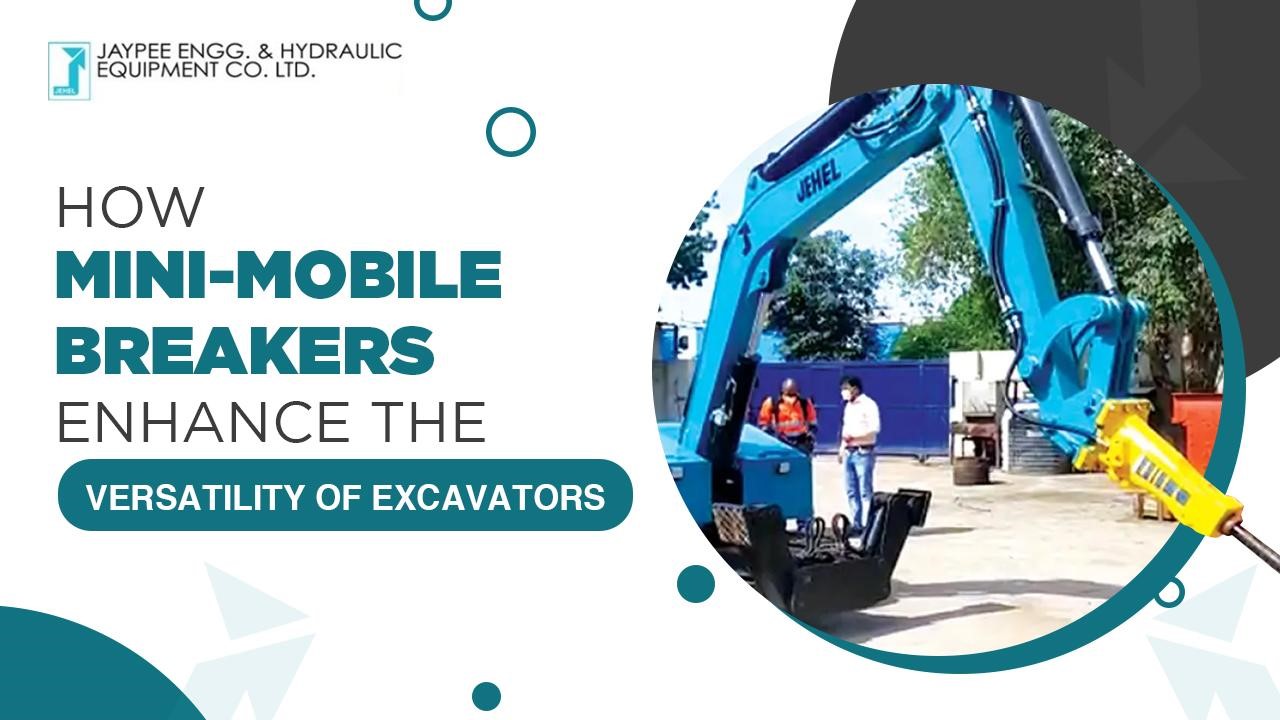Versatility is no longer a luxury in current construction and heavy industry— it’s a requirement. Businesses are subject to relentless pressure to complete work faster, cheaper, and safely in harsh conditions. To address these challenges, equipment must be capable of performing multiple functions. That is where mini-mobile breakers come in.
When you equip an excavator with a mini-mobile breaker, you immediately convert it into a multi-function tool. Rather than relying on heavy, single-function machines or manual labor, you have a lightweight, yet strong solution that can perform specialized tasks across various industries. From steel plants to cement kilns, these attachments are making quietly subtle changes in how brutal demolition and breaking tasks are completed.
What Makes Mini-Mobile Breakers Special?
Mini-mobile breakers are compact hydraulic attachments that pack a big punch. They capitalize on the excavator’s hydraulic power to provide controlled, high-impact force—sufficient to break concrete, slag, rock, and refractory buildups, yet small enough to fit into confined spaces.
Mini-mobile units differ from conventional heavy breakers in that they are optimized for:
- Mobility – Simple to take between locations or shift across plant floors.
- Accuracy – Gently breaking action without harming surrounding structures.
- Constricted Use – Capability to operate in small spaces such as kiln interiors, cramped alleys, or among equipment.
- Efficiency – Reduced noise, vibration, and fuel usage relative to older technology.
Their power and maneuverability balance out, making them revolutionary, especially in sectors where material deposits solidify into impenetrable clogs.
Top Applications in Heavy Industry
Mini-mobile breakers are not only used in construction—mini-mobile breakers have an essential function in fields where breaking is slow, unsafe, and expensive.
-
Debricking in Cement Kilns
Cement kilns require periodic debricking—the removal of worn refractory linings—which is traditionally labor-intensive, slow, and hazardous. Manual debricking exposes workers to confined, high-temperature environments and risks of falling debris. Mini-mobile breakers simplify this process by:
- Entering narrow kiln interiors inaccessible to large equipment
- Quickly breaking and removing refractory bricks, restoring operational readiness
- Reducing downtime and preventing costly production delays
- Improving worker safety by minimizing manual hammering inside hot, confined spaces
-
Ladle Skull Breaking in Steel Plants
In steel mills, molten metal hardens within casting ladles, creating what is referred to as a “skull.” Such skulls are complex, irregular, and difficult to break, rendering ladles useless until they are decontaminated. Mini-mobile breakers facilitate the task by:
- Applying focused force to break skulls without ruining the structure of the ladle
- Accelerating ladle turnaround for a non-stop casting operation
- Reducing manual hammering needs, which is unsafe and work-intensive
- Reducing maintenance expense through lengthening the life cycle of costly casting ladles
-
Accretion Demolition in DRI Kiln
Direct Reduced Iron (DRI) kilns often face accretion formation—dense build-ups that obstruct material flow and lower efficiency. Conventional removal is slow, labor-intensive, and risky. With a mini-mobile breaker, operators can:
- Rapidly break down tough accretions compared to manual methods.
- Reduce worker fatigue and risks, ensuring safer operations.
- Cut kiln downtime, improving output for sponge iron producers.
- Handle both light chipping and heavy accretion demolition with one versatile tool.
-
Uses in the Sponge Iron Sector
The sponge iron sector is constantly confronted with kiln accretions and refractory degradation. Mini-mobile breakers are now indispensable here since they:
- Effectively remove jamming and depositions within DRI kilns
- Enhance plant availability through quicker and simpler maintenance
- Provide accurate breaking force to address both accretion removal and debricking
- Minimize dependence on big, stationary machines that do not fit into smaller plant settings
Wider Benefits Across Other Industries
Though their main application is in cement, steel, and sponge iron, mini-mobile breakers deliver benefits across a broad spectrum of industries:
Construction – Demolishing old concrete structures, foundations, and highway surfaces.
Utilities – Rock and concrete removal for pipeline construction and maintenance.
Mining & Quarrying – Breaking by fragmenting ore and hard rock without damaging surrounding formations.
Landscaping – Breaking boulders, stump removal, and preparing land for development.
Their versatility makes one investment profitable in a variety of applications.
Why Mini-Mobile Breakers are Cost-Effective
Certain factors and reasons make mono mobile breakers quite cost-effective:
- Space-Saving Design – Perfect for compact plant layouts and congested building sites.
- Lower Costs – One machine handles both excavation and breaking, reducing rentals, transportation, and personnel costs.
- Fast Setup – Simple to hook and unhook, allowing for easy task switching.
- Sustainability – Lower noise and fuel consumption make them ideal for residential and sensitive locations.
By enhancing efficiency and reducing costs, they deliver a robust return on investment for both plant owners and contractors.
The Future
As industries continue to modernize, the use of compact hydraulic attachments is expected to grow. Mini-mobile breakers of the future will come equipped with:
- Intelligent Sensors – Online operational data to fine-tune operations.
- Condition-Based Maintenance – Receive notifications before breakdowns to minimize downtime and prevent unexpected disruptions.
- Environmental Designs – Less noisy, more fuel-efficient systems to comply with environmental regulations.
The synergy of technology, compactness, and multi-industry use guarantees mini-mobile breakers will continue to be a must-have in the years to come.
Conclusion
Mini-mobile breakers are not an add-on—they are a vital piece of equipment for industries fighting accretions, refractory buildup, and skulls in casting ladles. In cement kilns, DRI kilns, or sponge iron plants, they reduce downtime, enhance safety, and boost productivity.


